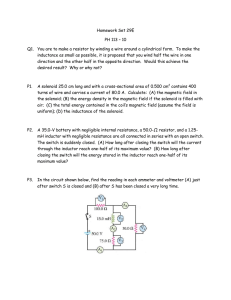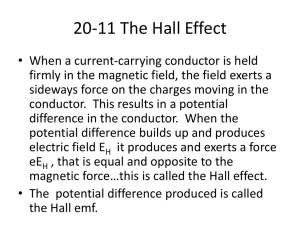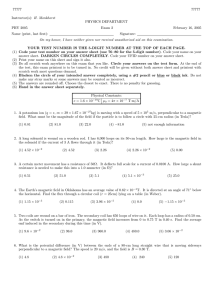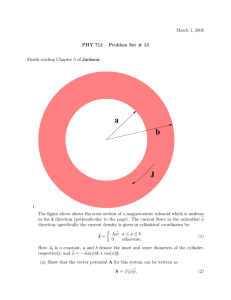Wednesday, Mar. 29, 2006
advertisement
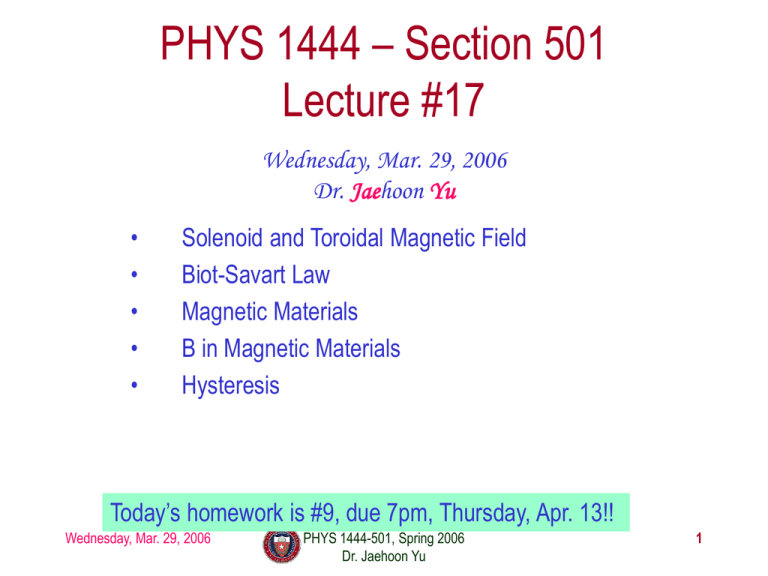
PHYS 1444 – Section 501 Lecture #17 Wednesday, Mar. 29, 2006 Dr. Jaehoon Yu • • • • • Solenoid and Toroidal Magnetic Field Biot-Savart Law Magnetic Materials B in Magnetic Materials Hysteresis Today’s homework is #9, due 7pm, Thursday, Apr. 13!! Wednesday, Mar. 29, 2006 PHYS 1444-501, Spring 2006 Dr. Jaehoon Yu 1 Announcements • Reading assignments – CH28 – 7, 28 – 8, 28 – 9 and 28 – 10 • Two Colloquia you must attend – Dr. H. Weerts, director of High Energy Physics Division at Argonne National Laboratory • Friday, Apr. 21 • International Linear Collider: The Physics and Its Challenges – Dr. I. Hinchcliff, Lorentz Berkley Laboratory • Wednesday, Apr. 26 • Title: Early Physics with ATLAS at the LHC • Term exam #2 – Date and time: 5:30 – 6:50pm, Wednesday, Apr. 5 – Location: SH103 – Coverage: Ch. 25 – 4 to Ch. 28 Wednesday, Mar. 29, 2006 PHYS 1444-501, Spring 2006 Dr. Jaehoon Yu 2 Solenoid and Its Magnetic Field • What is a solenoid? – A long coil of wire consisting of many loops – If the space between loops are wide • The field near the wires are nearly circular • Between any two wires, the fields due to each loop cancel • Toward the center of the solenoid, the fields add up to give a field that can be fairly large and uniform Solenoid Axis – For a long, densely packed loops • The field is nearly uniform and parallel to the solenoid axes within the entire cross section • The field outside the solenoid is very small compared to the field inside, except the ends – The same number of field lines spread out to an open space Wednesday, Mar. 29, 2006 PHYS 1444-501, Spring 2006 Dr. Jaehoon Yu 3 Solenoid Magnetic Field • Now let’s use Ampere’s law to determine the magnetic field inside a very long, densely packed solenoid • Let’s choose the path abcd, far away from the ends – We can consider four segments of the loop for integral b c d a – B dl B dl B dl B dl B dl a b c d – The field outside the solenoid is negligible. So the integral on ab is 0. – Now the field B is perpendicular to the bc and da segments. So these integrals become 0, also. Wednesday, Mar. 29, 2006 PHYS 1444-501, Spring 2006 Dr. Jaehoon Yu 4 Solenoid Magnetic Field – So the sum becomes: B dl B dl Bl c – If the current I flows in the wire of the solenoid, the total current enclosed by the closed path is NI d • Where N is the number of loops (or turns of the coil) enclosed – Thus Ampere’s law gives us Bl 0 NI – If we let n=N/l be the number of loops per unit length, the magnitude of the magnetic field within the solenoid becomes – B nI 0 • B depends on the number of loops per unit length, n, and the current I – Does not depend on the position within the solenoid but uniform inside it, like a bar magnet Wednesday, Mar. 29, 2006 PHYS 1444-501, Spring 2006 Dr. Jaehoon Yu 5 Example 28 – 8 Toroid. Use Ampere’s law to determine the magnetic field (a) inside and (b) outside a toroid, which is like a solenoid bent into the shape of a circle. (a) How do you think the magnetic field lines inside the toroid look? Since it is a bent solenoid, it should be a circle concentric with the toroid. If we choose path of integration one of these field lines of radius r inside the toroid, path 1, to use the symmetry of the situation, making B the same at all points on the path, we obtain from Ampere’s law 0 NI Solving for B B 2 r NI I B dl B 0 encl 0 2 r So the magnetic field inside a toroid is not uniform. It is larger on the inner edge. However, the field will be uniform if the radius is large and the toroid is thin and B = 0nI. (b) Outside the solenoid, the field is 0 since the net enclosed current is 0. Wednesday, Mar. 29, 2006 PHYS 1444-501, Spring 2006 Dr. Jaehoon Yu 6 Biot-Savart Law • Ampere’s law is useful in determining magnetic field utilizing symmetry • But sometimes it is useful to have another method of using infinitesimal current segments for B field – Jean Baptiste Biot and Feilx Savart developed a law that a current I flowing in any path can be considered as many infinitesimal current elements – The infinitesimal magnetic field dB caused by the infinitesimal length dl that carries current I is 0 I dl rˆ – Biot-Savart Law dB 2 4 r • r is the displacement vector from the element dl to the point P • Biot-Savart law is the magnetic equivalent to Coulomb’s law 1444-501, Spring B field in Biot-Savart lawPHYS is only that by2006 the current, nothing else. Wednesday, Mar. 29, 2006 Dr. Jaehoon Yu 7 Example 28 – 9 B due to current I in a straight wire. For the field near a long straight wire carrying a current I, show that the Biot-Savarat law gives the same result as the simple long straight wire, B=0I/2R. What is the direction of the field B at point P? Going into the page. All dB at point P has the same direction based on right-hand rule. The magnitude of B using Biot-Savart law is dl rˆ 0 I dy sin I 0 B dB 2 4 y r 2 4 r Where dy=dl and r2=R2+y2 and since y R cot we obtain r 2 d Rd Rd 2 dy R csc d 2 2 R sin R r Integral becomes B Wednesday, Mar. 29, 2006 0 I 4 dy sin 0 I 1 2 y 4 R r 0 sin d 0 I 1 I 1 cos 0 0 4 R 2 R PHYS 1444-501, Spring 2006 The same as the simple, long straight wire!! It works!! Dr. Jaehoon Yu 8 Magnetic Materials - Ferromagnetism • Iron is a material that can turn into a strong magnet – This kind of material is called ferromagnetic material • In microscopic sense, ferromagnetic materials consists of many tiny regions called domains – Domains are like little magnets usually smaller than 1mm in length or width • What do you think the alignment of domains are like when they are not magnetized? – Randomly arranged • What if they are magnetized? – The size of the domains aligned with the external magnetic field direction grows while those of the domains not aligned reduce – This gives magnetization to the material • How do we demagnetize a bar magnet? – Hit the magnet hard or heat it over the Curie temperature Wednesday, Mar. 29, 2006 PHYS 1444-501, Spring 2006 Dr. Jaehoon Yu 9 B in Magnetic Materials • What is the magnetic field inside a solenoid? B0 0 nI • – Magnetic field in a long solenoid is directly proportional to the current. – This is valid only if air is inside the coil • What do you think will happen to B if we have something other than the air inside the solenoid? – It will be increased dramatically, when the current flows • Especially if a ferromagnetic material such as an iron is put inside, the field could increase by several orders of magnitude • Why? – Since the domains in the iron aligns permanently by the external field. – The resulting magnetic field is the sum of that due to current and due to the iron Wednesday, Mar. 29, 2006 PHYS 1444-501, Spring 2006 Dr. Jaehoon Yu 10 B in Magnetic Materials • It is sometimes convenient to write the total field as the sum of two terms • B B0 BM – B0 is the field due only to the current in the wire, namely the external field • The field that would be present without a ferromagnetic material – BM is the additional field due to the ferromagnetic material itself; often BM>>B0 • The total field in this case can be written by replacing 0 with another proportionality constant , the magnetic permeability of the material B nI – is a property of a magnetic material – is not a constant but varies with the external field Wednesday, Mar. 29, 2006 PHYS 1444-501, Spring 2006 Dr. Jaehoon Yu 11 • Hysteresis What is a toroid? – A solenoid bent into a shape • Toroid is used for magnetic field measurement – Why? – Since it does not leak magnetic field outside of itself, it fully contains all the magnetic field created within it. • Consider an un-magnetized iron core toroid, without any current flowing in the wire – – – – What do you think will happen if the current slowly increases? B0 increases linearly with the current. And B increases also but follows the curved line shown in the graph As B0 increases, the domains become more aligned until nearly all are aligned (point b on the graph) • The iron is said to be approaching saturation • Point b is typically at 70% of the max Wednesday, Mar. 29, 2006 PHYS 1444-501, Spring 2006 Dr. Jaehoon Yu 12 Hysteresis • What do you think will happen to B if the external field B0 is reduced to 0 by decreasing the current in the coil? – Of course it goes to 0!! – Wrong! Wrong! Wrong! They do not go to 0. Why not? – The domains do not completely return to random alignment state • Now if the current direction is reversed, the external magnetic field direction is reversed, causing the total field B pass 0, and the direction reverses to the opposite side – If the current is reversed again, the total field B will increase but never goes through the origin • This kind of curve whose path does not retrace themselves and does not go through the origin is called the Hysteresis. Wednesday, Mar. 29, 2006 PHYS 1444-501, Spring 2006 Dr. Jaehoon Yu 13 Magnetically Soft Material • In a hysteresis cycle, much energy is transformed to thermal energy. Why? – Due to the microscopic friction between domains as they change directions to align with the external field • The energy dissipated in the hysteresis cycle is proportional to the area of the hysteresis loop • Ferromagnetic material with large hysteresis area is called magnetically hard while the small ones are called soft – Which ones do you think are preferred in electromagnets or transformers? • Soft. Why? • Since the energy loss is small and much easier to switch off the field • Then how do we demagnetize a ferromagnetic material? – Keep repeating the Hysteresis loop, reducing the range of B0. Wednesday, Mar. 29, 2006 PHYS 1444-501, Spring 2006 Dr. Jaehoon Yu 14



